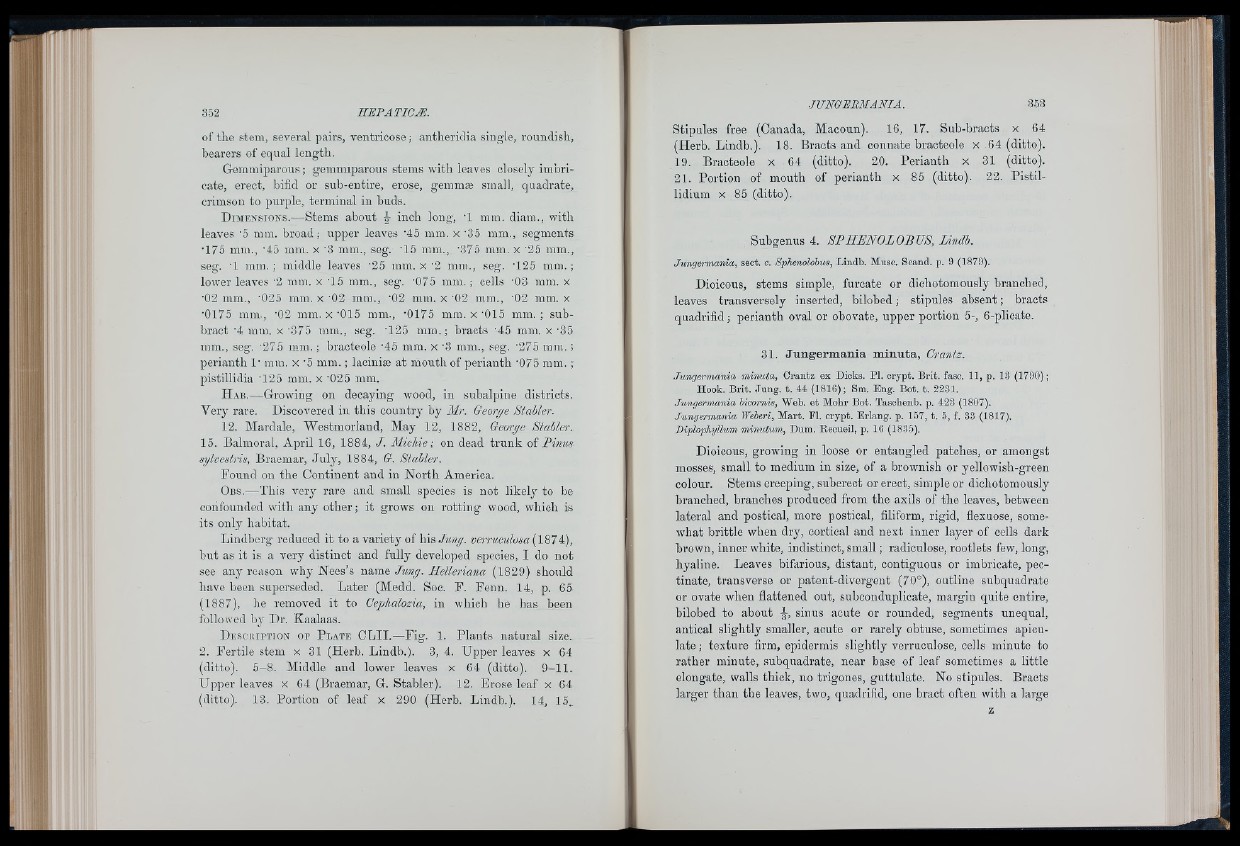
of th e stem, several qjairs, v en trico se; a n th e rid ia single, ro u ndish,
bearers of equal len g th .
Gemmiparous ; gemmiparous stems with leaves closely imbricate,
erect, bifid or sub-entire, erose, gemmæ small, quadrate,,
crimson to purple, terminal in buds.
D imensions.— Stems ab o u t -J- inch long, T mm. diam., with
leaves '5 mra. b ro ad ; up p e r leaves '45 mm. x '35 mm., segments
T 7 5 mni., '45 mm. x '3 mm., seg. T 5 mm., '375 mm. x '25 mm.,
seg. T ram .; middle leaves '25 mm. x '2 mm., seg. T 2 5 m m .;
lower leaves '2 mm. x T5 mm., seg. '075 mm. ; cells '03 mm. x
■02 mm,, '025 mm. x '02 mm., ’02 mm. x '0 2 mm., '02 mm. x
■0175 mm., '02 mm. x '015 inm., ’0175 mm. x ’015 mm. ; sub-
hraot '4 mm. x '375 mm., seg. ’125 m m .; b racts '45 mm. x -35
mm., seg. '275 mm. ; bracteole '45 mm. x -3 mm., seg. '275 mm. ;
p e ria n th 1' ram. x '5 mm. ; laciniæ a t m o u th of p e ria n th '075 mm. ;
p istillid ia '125 mm. x '025 mm.
H a b .— Growing on decaying wood, in subalpine districts.
Very rare. Discovered in this country by Ah; George Stabler.
12. Mardale, Westmorland, May 12, 1882, George Stabler.
15. Balmoral, April 16, 1884, / . Michie ; on dead trunk of Finns
sglvestris, Braemar, July, 1884, G. Stabler.
Found on the Continent and in North America.
O b s .— T h is very ra re an d small species is n o t lik e ly to be
confounded w ith any o th er ; it grows on ro ttin g wood, which is
its only h ab ita t.
Lindberg reduced it to a variety of his Jung, verruculosa {187A),
but as it is a very distinct and fully developed species, I do not
see any reason why Nees’s name Jung. Helleriana (1829) should
have been superseded. Later (Medd. Soc. F. Fenn. 14, p. 65
(1887), he removed it to Cephalozia, in which he has been
followed bj' Dr. Kaalaas.
D escription of P late CL II.—Fig. 1. Plants natural size..
2. Fertile stem x 31 (Herb. Lindb.). 3, 4. Upper leaves x 64
(ditto). 5-8. Middle and lower leaves x 64 (ditto). 9-11.
Upper leaves x 64 (Braemar, G. Stabler). 12. Erose leaf x 64
(ditto). 13. Portion of leaf x 290 (Herb. Lindb.). 14, 15..
Stipules free (Canada, Maooun). 16, 17. Sub-braots x 64
(Herb. Lindb.). 18. Bracts and connate bracteole x 64 (ditto).
19. Bracteole x 64 (ditto). 20. Perianth x 31 (ditto).
21. Portion of mouth of perianth x 85 (ditto). 22. Pistillidium
x 85 (ditto).
Subgenus 4. SPHENOLOBUS, Lindb.
Jungermania, sect. c. Sphenolohus, Lindb. Muse. Scand. p. 9 (1879).
Dioicous, stems simple, furcate or dichotomously branched,
leaves transversely inserted, bilobed; stipules absent; bracts
quadrifid; perianth oval or obovate, upper portion 5-, 6-plicate.
31. Ju n g e rm an ia minuta, Crantz.
Jungermania minuta, Crantz ex Dicks. PI. crypt. Brit. fasc. 11, p. 13 (1790);
Hook. Brit. Ju n g . t. 44 (1816); Sm. Eng. Bot. t. 2231.
Jungermania hicornis, Web. et Mohr Bot. Taschenb. p. 423 (1807).
Jungei'-mania Weberi, Mart. Fl. crypt. Erlang, p. 157, t, 5, f. 33 (1817).
Diplophyllum minutum, Dum. Recueil, p. 16 (1835),
Dioicous, growing in loose or entangled patches, or amongst
mosses, small to medium in size, of a brownish or yellowish-green
colour. Stems creeping, suberect or erect, simple or dichotomously
branched, branches produced from the axils of the leaves, between
lateral and postical, more postical, filiform, rigid, flexuose, somewhat
brittle when dry, cortical and next inner layer of cells dark
brown, inner white, indistinct, small; radiculose, rootlets few, long,
hyaline. Leaves bifarious, distant, contiguous or imbrioate, pectinate,
transverse or patent-divergent (70°), outline suhquadrate
or ovate when flattened out, subconduplioate, margin quite entire,
bilobed to about -J-, sinus acute or rounded, segments unequal,
antical slightly smaller, acute or rarely obtuse, sometimes apiculate
; texture firm, epidermis slightly verruculose, cells minute to
rather minute, suhquadrate, near base of leaf sometimes a little
elongate, walls thick, no trigones, guttulate. No stipules. Bracts
larger than the leaves, two, quadrifid, one bract often with a large